Assembly of the International Space Station



The process of assembling the International Space Station (ISS) has been under way since the 1990s. Zarya, the first ISS module, was launched by a Proton rocket on 20 November 1998. The STS-88 shuttle mission followed two weeks after Zarya was launched, bringing Unity, the first of three node modules, and connecting it to Zarya. This bare 2-module core of the ISS remained unmanned for the next one and a half years, until in July 2000 the Russian module Zvezda was added, allowing a maximum crew of two astronauts or cosmonauts to be on the ISS permanently.
The ISS has a planned pressurized volume of approximately 1,000 cubic meters, a mass of approximately 400,000 kilograms, approximately 100 kilowatts of power output, a truss 108.4 meters long, modules 74 meters long, and a crew of six. Building the complete station will require more than 40 assembly flights. As of March 2011, 26 Space Shuttle flights have docked with ISS to add elements, and 9 other Shuttle flights have flown logistics-servicing missions to ISS without adding major external elements. These 35 Shuttle missions include 9 SpaceHab and 10 MPLM logistics-servicing missions in various combinations. The last two planned Shuttle flights are due to add one of the two final elements of ISS, followed by one last Proton launch with the planned delivery of the ERA. Other assembly flights have consisted of modules lifted by the Russian Proton rocket or in the case of Pirs and Poisk by a Soyuz-U rocket.
Some of the larger modules include:
- Zarya (launched 20 November 1998)
- Unity Module (launched 4 December 1998, also known as Node 1)
- Zvezda (launched 12 July 2000)
- Destiny Laboratory Module (launched 7 February 2001)
- Columbus orbital facility (launched 7 February 2008)
- Japanese Experiment Module, also known as Kibo (launched in multiple flights between 2008-2009)
- The truss and solar panels are also a large part of the station. (launched in multiple flights between 2000-2009)
Logistics
The space station is located in orbit around the Earth at an altitude of approximately 410 km (250 mi), a type of orbit usually termed low Earth orbit (the actual height varies over time by several kilometers due to atmospheric drag and reboosts). It orbits Earth in a period of about 90 minutes; by August 2007 it had completed more than 50,000 orbits since launch of Zarya on 20 November 1998.
A total of 14 main pressurized modules are scheduled to be part of the ISS by its completion date in 2010.[1] A number of smaller pressurized sections will be adjunct to them (Soyuz spacecraft (permanently 2 as lifeboats - 6 months rotations), Progress transporters (2 or more), the Quest and Pirs airlocks, as well as periodically the Multi-Purpose Logistics Module, the Automated Transfer Vehicle and the H-II Transfer Vehicle).
The ISS, when completed, will consist of a set of communicating pressurized modules connected to a truss, on which four large pairs of photovoltaic modules (solar panels) are attached. The pressurized modules and the truss will be perpendicular: the truss spanning from starboard to port and the habitable zone extending on the aft-forward axis. Although during the construction the station attitude may vary, when all four photovoltaic modules are in their definitive position the aft-forward axis will be parallel to the velocity vector.[2]
In addition to the assembly and utilization flights, approximately 30 Progress spacecraft flights are required to provide logistics until 2010. Experimental equipment, fuel and consumables are and will be delivered by all vehicles visiting the ISS: the Shuttle, the SpaceX Dragon, the Russian Progress, the European ATV and the Japanese HTV, and space station downmass will be carried back to Earth facilities on both the Shuttle and the Dragon.[3]
Columbia disaster and changes in construction plans

Disaster and consequences

At one point, there was some uncertainty over the future of the ISS. The Space Shuttle Columbia disaster on 1 February 2003, the subsequent two and a half-year suspension of the U.S. Space Shuttle program, followed by problems with resuming flight operations in 2005, were major obstacles.
The Space Shuttle program resumed flight on 26 July 2005, with the STS-114 mission of Discovery. This mission to the ISS was intended both to test new safety measures implemented since the Columbia disaster, and to deliver supplies to the station. Although the mission succeeded safely, it was not without risk; foam was shed by the external tank, leading NASA to announce future missions would be grounded until this issue was resolved.
Between the Columbia disaster and the resumption of Shuttle launches, crew exchanges were carried out solely using the Russian Soyuz spacecraft. Starting with Expedition 7, two-astronaut caretaker crews were launched in contrast to the previously launched crews of three. Because the ISS had not been visited by a shuttle for an extended period, a larger than planned amount of waste accumulated, temporarily hindering station operations in 2004. However Progress transports and the STS-114 shuttle flight took care of this problem.
Changes in construction plans
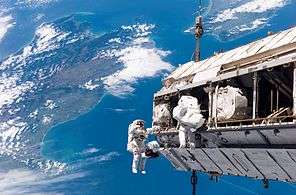
ISS construction experienced delays due to the halting of all NASA Shuttle flights following the Columbia disaster in early 2003, although there had been prior delays due to Shuttle problems, and the Russian space agency's budget constraints. During the shuttle stand-down, construction of the ISS was halted and the science conducted aboard was limited due to the crew size of two. Many changes were made to the originally planned ISS, even before the Columbia disaster. Modules and other structures were cancelled or replaced and the number of Shuttle flights to the ISS was reduced from previously planned numbers. However more than 80% of the hardware intended to be part of the ISS in the late 1990s was orbited and is now part of the ISS's configuration.
In March 2006, a meeting of the heads of the five participating space agencies accepted the new ISS construction schedule that plans to complete the ISS by 2010.[4] A crew of six has been established as of May 2009, following 12 Shuttle construction flights after the second "Return to Flight" mission STS-121. Requirements for stepping up the crew size included enhanced environmental support on the ISS, a second Soyuz permanently docked on the station to function as a second 'lifeboat', more frequent Progress flights to provide double the amount of consumables, more fuel for orbit raising maneuvers, and a sufficient supply line of experimental equipment.
Later additions included the Bigelow Expandable Activity Module (BEAM) in 2016, and numerous Russian components are planned as part of the in-orbit construction of OPSEK.
Assembly sequence

The ISS is made up of 15 pressurized modules: five Russian modules (Zarya, Pirs, Zvezda, Poisk and Rassvet), seven US modules (Leonardo, Harmony, Quest, Tranquility, Unity, Cupola, and Destiny), two Japanese modules (the JEM-ELM-PS and JEM-PM) and one European module (Columbus). One more Russian pressurized module (Nauka) is scheduled to be added to the station.
Although not permanently docked with the ISS, Multi-Purpose Logistics Modules (MPLMs) form part of the ISS during some Shuttle missions. An MPLM is attached to Harmony (initially to Unity) and is used for resupply and logistics flights.
Spacecraft attached to the ISS also extend the pressurized volume. At least one Soyuz spacecraft is always docked as a 'lifeboat' and is replaced every six months by a new Soyuz as part of crew rotation.
The table below shows the sequence in which these components were or will be added to the ISS. The numbers provided are indications and represent launch weight and dimensions.
| Element | Assembly flight |
Launch date |
Launch vehicle |
Length (m) |
Diameter (m) |
Mass (kg) |
Pressurized Volume (m^3) |
Isolated View | Station View |
|---|---|---|---|---|---|---|---|---|---|
| Zarya (FGB)[5] | 1A/R | 1998-11-20 | Proton-K | 12.6 | 4.1 | 19,323 |  |
 | |
| Unity (Node 1),[6] PMA-1 & PMA-2 | 2A | 1998-12-04 | Space Shuttle Endeavour (STS-88) | 5.49 | 4.57 | 11,612 |  |
 | |
| Zvezda (Service Module)[7] | 1R | 2000-07-12 | Proton-K | 13.1 | 4.15 | 19,051 | 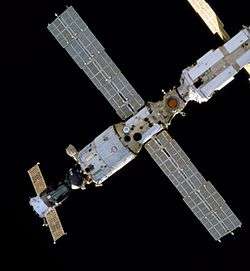 |
 | |
| Z1 Truss & PMA-3 | 3A | 2000-10-11 | Space Shuttle Discovery (STS-92) | 4.9 (Z1) | 4.2 (Z1) | 8,755 (Z1) |  |
 | |
| P6 Truss & Solar Arrays | 4A | 2000-11-30 | Space Shuttle Endeavour (STS-97) | 73.2 | 4.9 | 15,824 |  | ||
| Destiny (US Laboratory)[8] | 5A | 2001-02-07 | Space Shuttle Atlantis (STS-98) | 8.53 | 4.27 | 14,515 |  |
 | |
| External Stowage Platform-1 | 5A.1 | 2001-03-08 | Space Shuttle Discovery (STS-102) |  |
 | ||||
| Canadarm2 (SSRMS) | 6A | 2001-04-19 | Space Shuttle Endeavour (STS-100) | 17.6 | 0.35 | 4,899 |  |
 | |
| Quest (Joint Airlock)[9] | 7A | 2001-07-12 | Space Shuttle Atlantis (STS-104) | 5.5 | 4 | 6,064 |  |
 | |
| Pirs (Docking Compartment & Airlock) | 4R | 2001-09-14 | Soyuz-U (Progress M-SO1) |
4.91 | 2.55 | 3,580 |  |
 | |
| S0 Truss[10] | 8A | 2002-04-08 | Space Shuttle Atlantis (STS-110) | 13.4 | 4.6 | 13,970 |  |
 | |
| Mobile Base System | UF2 | 2002-06-05 | Space Shuttle Endeavour (STS-111) | 5.7 | 2.9 | 1,450 |  |
 | |
| S1 Truss | 9A | 2002-10-07 | Space Shuttle Atlantis (STS-112) | 13.7 | 4.6 | 14,120 |  |
 | |
| P1 Truss | 11A | 2002-11-23 | Space Shuttle Endeavour (STS-113) | 13.7 | 4.6 | 14,000 | 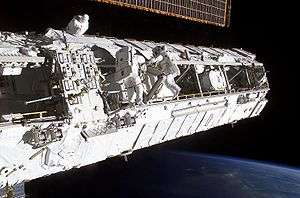 |
| |
| ESP-2 | LF1 | 2005-07-26 | Space Shuttle Discovery (STS-114) | 3.65 | 4.9 | 2,676 |  |
 | |
| P3/P4 Truss & Solar Arrays[11] | 12A | 2006-09-09 | Space Shuttle Atlantis (STS-115) | 13.8 | 4.9 | 15,900 |  |
 | |
| P5 Truss[12] | 12A.1 | 2006-12-09 | Space Shuttle Discovery (STS-116) | 3.4 | 4.6 | 1,818 | .jpg) |
 | |
| S3/S4 Truss & Solar Arrays | 13A | 2007-06-08 | Space Shuttle Atlantis (STS-117) | 13.8 | 4.9 | 15,900 |  |
 | |
| S5 Truss and ESP-3 | 13A.1 | 2007-08-08 | Space Shuttle Endeavour (STS-118) | 13.7 | 3.9 | 12,598 | 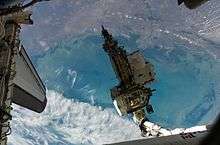 |
 | |
| Harmony (Node 2) Relocation of P6 Truss |
10A | 2007-10-23 | Space Shuttle Discovery (STS-120) | 7.2 | 4.48 | 14,288 |  |
 | |
| Columbus (European Laboratory)[13] | 1E | 2008-02-07 | Space Shuttle Atlantis (STS-122) | 7 | 4.5 | 12,800 |  |
 | |
| Dextre (SPDM) Japanese Logistics Module (ELM-PS) |
1J/A | 2008-03-11 | Space Shuttle Endeavour (STS-123) | 3.9 (ELM-PS) | 4.4 (ELM-PS) | 4,200 (ELM-PS) |  |
 | |
| Japanese Pressurized Module (JEM-PM) JEM Robotic Arm (JEM-RMS)[14][15] |
1J | 2008-05-31 | Space Shuttle Discovery (STS-124) | 11.2 (JEM-PM) | 4.4 (JEM-PM) | 15,900 (JEM-PM) |  |
 | |
| S6 Truss & Solar Arrays | 15A | 2009-03-15 | Space Shuttle Discovery (STS-119) | 73.2 | 10.7 | 15,900 | .jpg) |
 | |
| Japanese Exposed Facility (JEM-EF) | 2J/A | 2009-07-15 | Space Shuttle Endeavour (STS-127) | 4,100 |  |
 | |||
| Poisk (MRM-2)[16][17] | 5R | 2009-11-10 | Soyuz-U (Progress M-MIM2) |
3,670 | |
 | |||
| ExPRESS Logistics Carriers 1 & 2 | ULF3 | 2009-11-16 | Space Shuttle Atlantis (STS-129) | |
 | ||||
| Cupola & Tranquility (Node 3) |
20A | 2010-02-08 | Space Shuttle Endeavour (STS-130) | 6.5 (Node 3) 1.5 (Cupola) |
4.25 (Node 3) 2.95 (Cupola) |
12,247 (Node 3) 1,800 (Cupola) |
|
 | |
| Rassvet (MRM-1)[18] | ULF4 | 2010-05-14 | Space Shuttle Atlantis (STS-132) | 5,075 |  |
 | |||
| Leonardo (PMM) and EXPRESS Logistics Carrier 4 | ULF5 | 2011-02-24 | Space Shuttle Discovery (STS-133) | 9,896 (Leonardo) |  |
 | |||
| Alpha Magnetic Spectrometer, OBSS and EXPRESS Logistics Carrier 3 | ULF6 | 2011-05-16 | Space Shuttle Endeavour (STS-134) | 6,731 (AMS-02) |  |
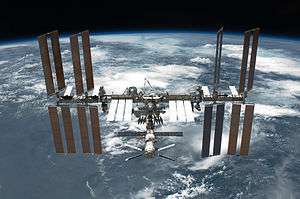 | |||
| Bigelow Expandable Activity Module[19] | 2016-04-08 | Falcon 9 | 4 | 3.2 | 1,360 |  |
|||
| Nauka (MLM) European Robotic Arm[20] |
3R | 2017 (scheduled) | Proton-M | 20,300 (Nauka) | 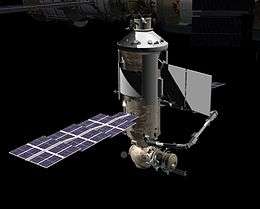 |
.jpg) | |||
| Nodal Module (UDM)[21] | 2018 (scheduled) [22] | Soyuz 2.1b | 4,000 | ||||||
| Science-Power Module-1[23] | 2019 (scheduled) [24] | Proton-M | |||||||
| Science-Power Module-2[23] | 2019 (scheduled) [24] | Proton-M | |||||||
| Element | Assembly flight |
Launch date |
Launch vehicle |
Length (m) |
Diameter (m) |
Mass (kg) |
Pressurized Volume (m^3) |
Isolated View | Station View |
Cancelled modules

- Interim Control Module - not needed once Zvezda was launched
- ISS Propulsion Module - not needed once Zvezda was launched
- Habitation Module (HAB) - With the cancellation of the Habitation Module, sleeping places are now spread throughout the station. There are two in the Russian segment and four in the US segment. It is not necessary to have a separate 'bunk' in space — many visitors just strap their sleeping bag to the wall of a module, get into it and sleep.
- Crew Return Vehicle (CRV) - replaced by two Soyuz spacecraft
- Centrifuge Accommodations Module (CAM) - would have been attached to Harmony (Node 2)
- Science Power Platform (SPP) - power will be provided to the Russian segments partly by the US solar cell platforms
- Russian Research Modules (RM1 and RM2) - to be replaced by single Multipurpose Laboratory Module (Nauka)
- Universal Docking Module (UDM) - canceled along with the Research Modules which were to connect to it
Proposed modules
The following modules are proposed, but not yet confirmed in the ISS launch manifests.
- American Node 4 - Also known as the Docking Hub System (DHS),[25] would allow the station to have more docking ports for visiting vehicles and would allow inflatable habitats and technology demonstrations to be tested as part of the station.[26]
- Nautilus-X Centrifuge Demonstration - If produced, this centrifuge will be the first in-space demonstration of sufficient scale centrifuge for artificial partial-g effects. It will be designed to become a sleep module for the ISS crew.[27]
-

Inflatable module attached to Node 4
-

Nautilus-X ISS demonstrator
See also
References
- ↑ "Consolidated Launch Manifest". NASA. Archived from the original on 7 July 2006. Retrieved 2006-07-15.
- ↑ "What are the ISS attitudes?" (Flash). NASA. Archived from the original on 2 September 2006. Retrieved 2006-09-11.
- ↑ Black, Charles (24 December 2012). "When Dragon made commercial spaceflight a reality". SEN. Retrieved 2012-12-26.
[Dragon's] ability to return goods is currently unique because all the other regular supply ships - Europe's Automated Transfer Vehicle (ATV), Japan's HTV (or "Kounotori") and Russia's Progress - all burn up during controlled re-entry.
- ↑ Coppinger, Rob (3 March 2006). "NASA commits to Shuttle missions to International Space Station". FlightGlobal. Retrieved 16 September 2006.
- ↑ Wade, Mark (15 July 2008). "ISS Zarya". Encyclopaedia Astronautica. Archived from the original on 27 February 2009. Retrieved 2009-03-11.
- ↑ "Unity Connecting Module: Cornerstone for a Home in Orbit" (PDF). NASA. January 1999. Archived (PDF) from the original on 17 March 2009. Retrieved 2009-03-11.
- ↑ "Zvezda Service Module". NASA. 11 March 2009. Archived from the original on 23 March 2009. Retrieved 2009-03-11.
- ↑ "US Destiny Laboratory". NASA. 26 March 2007. Archived from the original on 9 July 2007. Retrieved 2007-06-26.
- ↑ "Space Station Extravehicular Activity". NASA. 4 April 2004. Archived from the original on 3 April 2009. Retrieved 2009-03-11.
- ↑ "Space Station Assembly: Integrated Truss Structure". NASA. Archived from the original on 7 December 2007. Retrieved 2007-12-02.
- ↑ "P3 and P4 to expand station capabilities, providing a third and fourth solar array" (pdf). Boeing. July 2006. Retrieved 2007-12-02.
- ↑ "STS-118 MISSION OVERVIEW: BUILD THE STATION…BUILD THE FUTURE" (PDF). NASA PAO. July 2007. Archived (PDF) from the original on 1 December 2007. Retrieved 2007-12-02.
- ↑ "Columbus laboratory". ESA. 10 January 2009. Archived from the original on 30 March 2009. Retrieved 2009-03-06.
- ↑ "About Kibo". JAXA. 25 September 2008. Retrieved 2009-03-06.
- ↑ "Kibo Japanese Experiment Module". NASA. 23 November 2007. Archived from the original on 23 October 2008. Retrieved 2008-11-22.
- ↑ Zak, Anatoly. "Docking Compartment-1 and 2". RussianSpaceWeb.com. Archived from the original on 10 February 2009. Retrieved 26 March 2009.
- ↑ Bergin, Chris (9 November 2009). "Russian module launches via Soyuz for Thursday ISS docking". NASASpaceflight.com. Archived from the original on 13 November 2009. Retrieved 10 November 2009.
- ↑ "NASA Extends Contract With Russia's Federal Space Agency" (Press release). NASA. 9 April 2007. Archived from the original on 23 June 2007. Retrieved 2007-06-15.
- ↑ "NASA to Test Bigelow Expandable Module on Space Station". NASA. 16 January 2013. Retrieved 16 January 2013.
- ↑ "FGB-based Multipurpose Lab Module (MLM)". Khrunichev State Research and Production Space Centre. Archived from the original on 27 September 2007. Retrieved 2008-10-31.
- ↑ Zak, Anatoly (20 November 2012). "Node Module". RussianSpaceWeb. Retrieved 7 December 2012.
- ↑ "Node Module".
- 1 2 "NEM-1 module for the ISS RKK "Energy" to be built in cooperation" (in Russian). Korolyov, Moscow Oblast: RIA Novosti. 4 December 2012. Retrieved 7 December 2012.
- 1 2 "Russia works on a new-generation station module".
- ↑ ISS Managers review long-term configuration of International Space Station | NASASpaceFlight.com
- ↑ Test article could facilitate space station applications - 31 August 2010
- ↑ Nautilus-X-Holderman_1-26-11
External links
- Animated ISS assembly process, mission designations and dates are included.
- Diagram of planned components of the ISS, positions of cancelled modules can be seen.
- Media articles
